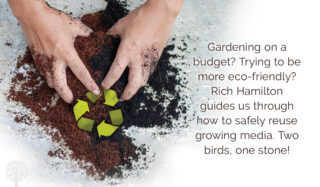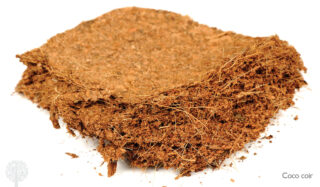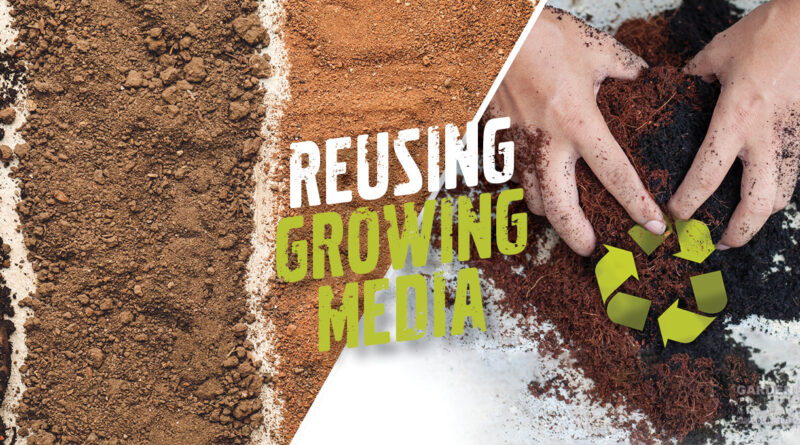Save Some Green, Go Green By Reusing Growing Media
Everyone is looking for ways to save money and grow sustainably. All gardening inputs can be managed to serve you more efficiently, including your growing media. You can use most growing media multiple times. However, you must ensure the media is suitable for reusing.
For example, a build-up of nutrients, diseased plant matter, fungal spores, or soil-borne pests can render a medium unusable. Therefore, it is essential to maintain it throughout each growth cycle and prepare it properly before reuse. Here, we will look at each popular growing medium and go through what you must do to reuse it safely.


Coco Coir
Prepare coco properly before reusing it, or crops will face many challenges, including salt toxicity. With each growth cycle, minerals and chemical compounds from plants and nutrient products accumulate in the growing medium. Too much salt in coco will stop nutrients from reaching the crops, resulting in nutrient lock-out. A salt-based nutrient lock-out can look like a nutrient deficiency, causing leaves to discolor and wilt. Nutrient lock-out will kill a crop if untreated.
To clean coco sufficiently, break it up and physically remove any remaining roots. Next, wash it in distilled water to remove any remaining salts. Soaking the coco in an enzyme solution to remove decaying roots from the previous crop is essential. Finally, add amendments such as mycorrhizae and other beneficial microorganisms.
When reusing coco multiple times, it loses some of its lignin structure. Therefore, replacing it entirely after two or three crop cycles is recommended. Some growers mix new coco into older coco to extend its life. However, it will still break down after a while and struggle to hold onto roots and maintain an optimal moisture level.


Once coco has been reused several times, discard it in the outdoor garden, making for a fantastic soil amendment. Used coco is suitable for outdoor flower beds and gardens or other areas where the soil has compacted. In addition, it will bring back aeration and improve water retention.
Avoid using recycled coco for seedlings or young cuttings, which are fragile; it is best to reserve reused coco for healthy, thriving plants. When planting new crops into reused coco, water profusely with calcium-rich, coir-specific nutrients and a good rooting stimulant until run-off occurs.
Potting Soil
As with coco, excess nutrients from previous crops will be left in the soil. Flushing these out is essential so you do not burn or lock out new crops with excess salts from the last harvest. It also means you can accurately dose your crops, knowing no significant nutrients are left in the soil.
Flushing the soil with a nutrient flush will rinse excess salts and heavy elements, leaving the soil cleaner. Even if you have already washed your soil in the final stages of your growth cycle, it is advisable to do it again if you plan to reuse it.
Give the soil a rest period and allow it to dry out, preferably in the sun. Many pathogens that growers encounter originate in the soil, including powdery mildew and root rot. Without this rest period, you risk infecting new plants. Allowing the soil to dry completely will drastically reduce disease spores. Don’t worry about any dry roots and stumps, as these will break down to form compost.
To reuse soil in pots, remove as much of the old root system for an even texture. Then, add soil amendments. For example, worm castings will help improve fertility, while perlite or peat moss will increase aeration and moisture retention.
Use a mycorrhizal inoculant before planting new crops in recycled soil. The mycorrhizal fungi form a symbiotic relationship with the plant roots, allowing for better nutrient and water uptake and improving growth and stress resistance.
If you have flushed the soil correctly, there will be relatively no nutrient availability, so a good feed at planting time is recommended. This will encourage rapid growth and reduce plant stress. In addition, maintain a proper fertilizing schedule to keep microorganisms and plants healthy.


Perlite/Clay Pebbles/Grow Stone
While made of entirely different materials, these growing media can be recycled similarly to potting soil and coco. However, a small amount will inevitably be lost to the plant’s root system as it extends around and grips onto the small pieces. Smaller roots may also break off and remain attached to the media. These must be removed, as small bits of root matter will decay and release CO2, suffocating fledgling root systems and transferring diseases to future crops.
To prevent this, soak the growing media with an enzyme wash. Enzyme flushes are commonly used during the growth cycle to break down dead plant matter washed out of the reservoir or made available by the plant. Once the roots are broken down, give it a good rinse and let the medium dry out for a few days before reusing. Like potting soil, allowing it to rest will help keep it sterile.
Reusing growing media is an excellent start to becoming a more sustainable gardener. However, there are limitations! Never go this route if a precious crop is diseased. If you’re not up for preparing and using old potting soil, you can still make the most of it instead of throwing it out. Disperse it directly into the outdoor garden or wherever you need to fill holes or eroded areas. You can also try mixing it into compost piles. This way, the old media can still help make you a more sustainable grower and save money at the same time.




